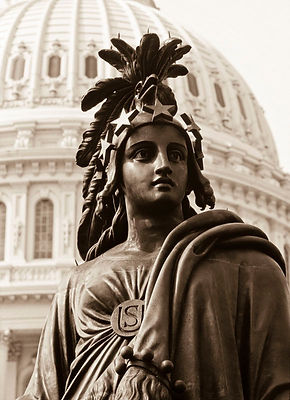
EVENTS

2025 PRESENTATIONS
Lady Freedom: Heart of a Nation, June 27, 2025, Northern California Connecting Consciousness online.
Recovering Our Ability to Bring Peace and Freedom Back into Our World, Ascended Masters Foundation Community, Saturday, July 12th, 2025. online.
Panel: Memorable Women Remembered: The History of the Nearly Forgotten Civil War Icon, July 30-August 1, 2025, The 118th Annual Meeting of the Pacific Coast Branch of the American Historical Association, “High-Stakes History: Studying the Past in a Perilous Present” Santa Clara University, - in person.
Unseen Untold History of The Statue of Freedom & America
Keynote Presentation March 15, 2023


THE REMEDIAL HERSTORY PROJECT
What is the lost history of the Statue of Freedom?
CAL ALUMNI CLUB
Saddle Club Dinner –February 20, 2020
Speaker & Topic: “The Secret atop the U.S. Capitol Dome” featuring Katya Miller, from the United States Capital Historical Society
The next Saddle Club Dinner will be held on Thursday February 20, 2020, with cocktails starting at 5 p.m. and buffet dinner at 6 p.m.
Our speaker will be Katya Miller, a United States Capital fellow speaking on the topic of the Statue of Freedom, erected on the Capital dome in 1863 which was hidden in plain site during the civil war.
Please join us to celebrate the winter season by sipping cocktails by the cozy fire in the club house and partaking in a delicious meal in the dining room with a spectacular view of the Trione Polo field and the Mayacamas mountains in the Valley of the Moon.
For more information, please read Katya Miller's Blog titled, America's Secret and her articles.


HOPE & HEALING for AMERICA
July 4, 2019 - Celebrate Freedom!
LADYFREEDOM
Center for Sacred Studies
13550 Church St, Guerneville, CA 95446
6:30-8:30 pm
Donations: 15.00-25.00
707-604-7362
Did you know there’s a Woman atop the Capitol Dome in Washington, DC? The statue — the image of FREEDOM — represents the Spiritual Consciousness of our Nation. Join us as, Katya Miller, historian and Fellow at the US Capitol Historical Society presents unknown history of America as a Woman. She will be joined by Kristen Farquhar, author and ‘one who works with healing sounds’ and ChoQosh, a Coastal Native American Elder and Wisdom Keeper. Let us begin to make things right.
Kris Farquhar
Monthly Program @ Institute for Historical Study
December 2, 2018
Anniversary of lifting the Statue to the top of the Dome on December 2, 1863.
“Nineteen thousand pounds of the most misunderstood woman in America”—as the New York Times characterized the statue of Freedom atop the United States Capitol—was the topic of new member Katya Miller’s presentation at the home of Nancy Zinn on December 2. It was the 155th birthday of Lady Freedom’s muted consecration in the middle of the Civil War. Katya’s planned book, “Beloved Freedom: Secret on the US Capitol Dome,” aims to reveal the history of her iconography and her creation by the American sculptor Thomas Crawford.
Crawford drew on European classical art and Native American imagery. Drapery folds echo the classical sculptures that Crawford studied in Rome; fur fringes on Freedom’s garment and her eagle headdress reflect Native culture. Katya’s research included not only documents and books in the Capitol Archives and Library of Congress, but also interviews with a number of Native authorities. Alice Papineau, the Onondaga clan mother, for example, taught her about matriarchy in Native culture. Other authorities taught her about the Onondaga Peace Tree, with its eagle on top. Peace is one theme in Lady Freedom, represented by a shield in her left hand; a sword in her right hand indicates protection from threats. European represen- tations of “America” as a native person, a staple of iconography from the time of exploration onward, also lie behind the final product.
Designs for the statue underwent three stages, beginning with Freedom Triumphant in War and Peace. Highlighting war was uncomfortable during a time of war, and the successor design—“Armed Liberty with a Liberty Cap”—merited rejection for that reason and also because the classical “liberty” or Phrygian cap originally denoted a freed slave—anathema to Jefferson Davis, one of the two commissioners of the statue. (Crawford did include a liberty cap in his frieze on the pediment of the Capitol.)
A specific Native emblem is the medallion reading “US” worn by Lady Freedom. It echoes peace medallions given by the Department of the Interior to Native leaders summoned to Washington. Katya noted the irony that during their visit the leaders also signed treaties disposing of their lands, treaties that they could not read.
“E pluribus unum,” inscribed on the statue’s pedestal, suggests more irony, reinforced by the fact that the statue was cast in bronze by a slave. The original plaster cast, restored at the instigation of a Native Hawai’ian woman, is now exhibited in the Capitol Visitors Center
(https://www.visitthecapitol.gov/exhibitions/ tour).
– Carol Sicherman
